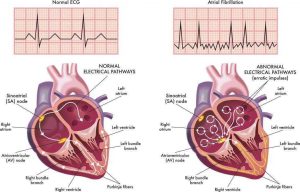Overview
Diagnosis
Atrial fibrillation (AFib) is often found during a routine health checkup or physical examination. To confirm the diagnosis, the healthcare professional listens to the heart, checks the pulse, and reviews personal and family medical history.
Additional tests may be recommended to identify underlying causes such as heart disease or thyroid disorders.
Tests to Diagnose AFib
Blood tests
These are done to look for conditions or substances that may affect the heart’s rhythm, including thyroid function or electrolyte imbalance.
Electrocardiogram (ECG or EKG)
This quick and painless test records the electrical activity of the heart. Sensors attached to the chest, arms, or legs detect abnormal rhythms. An ECG is the most common test to confirm atrial fibrillation.
Holter monitor
This is a small, wearable ECG device that records heart activity for 24 to 48 hours during normal daily activities.
Event recorder
Similar to a Holter monitor, this portable device is worn for up to 30 days and records only during irregular episodes. It can be triggered manually or automatically when abnormal rhythms occur.
Implantable loop recorder
This device is placed under the skin and continuously records heart rhythms for up to three years. It helps detect rare or intermittent episodes of AFib and is often used in people with an unexplained stroke or high risk of heart rhythm disorders.
Echocardiogram
Sound waves are used to create images of the heart. This shows heart structure, function, and how blood flows through the chambers and valves.
Exercise stress test
In this test, heart activity is monitored while walking on a treadmill or pedaling a stationary bike. If exercise isn’t possible, medication may be used to mimic the effect.
Chest X-ray
A chest X-ray helps evaluate the heart and lungs to detect other possible causes of irregular heartbeats.
Treatment
The goals of atrial fibrillation treatment are to restore normal heart rhythm, control heart rate, and prevent blood clots. The treatment plan depends on:
-
How long AFib has been present.
-
The severity of symptoms.
-
Underlying heart or thyroid conditions.
Treatment options may include medications, cardioversion therapy, or catheter and surgical procedures.
Medications
Heart rate control
-
Beta blockers help slow the heart rate.
-
Calcium channel blockers may also be used, though they’re avoided in some patients with heart failure or low blood pressure.
-
Digoxin helps control heart rate at rest but may be less effective during activity.
Heart rhythm control (anti-arrhythmic drugs)
These help reset or maintain a normal heart rhythm but are used selectively due to potential side effects.
Blood thinners (anticoagulants)
These prevent blood clots and lower stroke risk. Options may include warfarin or newer oral anticoagulants. Regular monitoring may be required depending on the medication.
Cardioversion Therapy
Cardioversion is a treatment that aims to reset the heart’s rhythm back to normal.
-
Electrical cardioversion uses controlled electric shocks through patches or paddles placed on the chest.
-
Drug cardioversion uses medications given orally or intravenously.
This procedure is often scheduled in a hospital and may require blood thinners beforehand to reduce the risk of stroke. After cardioversion, long-term medications may be needed to prevent recurrence.
Catheter and Surgical Procedures
Cardiac ablation
This minimally invasive procedure uses heat or cold energy to create small scars in the heart. These scars block abnormal signals that cause AFib. A catheter is guided through a blood vessel (usually from the groin) to the heart.
Atrioventricular (AV) node ablation
Heat energy is applied to the AV node to block abnormal signals. After this procedure, a permanent pacemaker is required to maintain heart rhythm.
Maze procedure
This involves creating a maze-like pattern of scar tissue in the heart’s upper chambers to block abnormal electrical signals. It can be done during open-heart surgery, often alongside other heart surgeries.
Hybrid ablation
This combines surgical and catheter ablation techniques for patients with persistent or complex AFib.
Pulsed field ablation
A newer technique that uses high-energy electric pulses instead of heat or cold to create scar tissue and stop irregular electrical activity.
Left atrial appendage closure
For patients who cannot take blood thinners, a closure device can be placed in the left atrial appendage — the area where most AFib-related clots form. This procedure helps reduce the risk of stroke.
Long-Term Management
-
Regular follow-up is essential to monitor heart rhythm and stroke risk.
-
Lifestyle changes, such as controlling blood pressure, maintaining a healthy weight, reducing caffeine and alcohol, and managing sleep apnea, can help reduce AFib episodes.
-
Many patients may need lifelong anticoagulant therapy or periodic rhythm monitoring.
Advertisement

